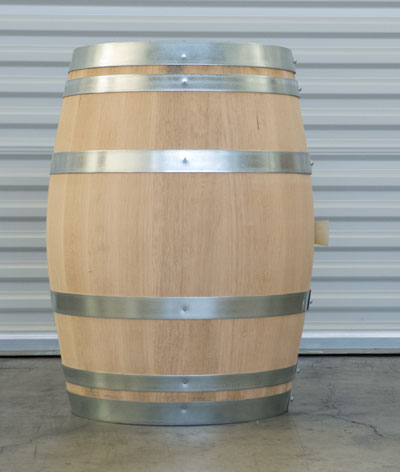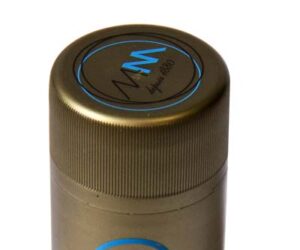Q
Many home winemakers have food grade plastic tubs (5 or 6-gallon volume) used for primary fermentation, stored for that fantastic next batch. I formerly used bleach to keep them clean, until I read about the bleach/corkiness connection. So, then I switched to sodium sulfite for the tubs. I’ve always kept an inch or so of relatively fresh sulfite solution in the covered tubs, to keep them sanitized (sometimes for months). Is this the best method, or would it be better to clean the tubs out, dry them, and keep them covered to exclude airborne beasties?
Ray Ruthenberg
Woodbine, Illinois
A
You’re on the right track — it’s not a good idea to mix chlorine bleach with winemaking because free chlorine molecules can, if the conditions are right, contribute to appreciable levels of the swampy or stinky “corked” aroma, the most ubiquitous being 2,4,6-trichloroanisole. I never use any chlorine-containing cleaning compounds in my winemaking and don’t recommend it to anyone. There are plenty of alternatives for cleaning, one of my favorites being sodium percarbonate. It also sanitizes (depletes microbial cell count) on clean surfaces as it contains 13% available oxygen and is a strong oxidizer.
You’re also on the right track by thinking it might be better to clean your fermenting tubs thoroughly and then dry them out to store them for next time. In my experience in the cellar, even closely-monitored “wet storage” solutions lose their potency with time. Forget to add more sodium metabisulfite powder to your storage solution, go on vacation for two weeks and you’ll probably come back to a microbial house party in your tub — hosted by those same “airborne beasties” you were trying to avoid in the first place. While many strains of bacteria are sensitive to even low levels of sulfites, most spoilage yeasts and other fungi are perfectly happy cohabitating with sulfur dioxide under 50 ppm, especially if the pH of the solution is above 3.0.
The best thing to do — relax and realize that, after all, you’re going to clean and sanitize your tubs before you ferment in them again, right? Take a cue from commercial wineries, which don’t worry about keeping crush-specific equipment 100% sanitized year-round. If it’s not going to be used for a few months or until next crush, remove any visible soil, scrub thoroughly (being gentle with stainless steel), rinse, dry and put the gear away in a safe and dry place. Many wineries even have to store equipment, like large pneumatic presses, outside and just clean them, let them air-dry and then just cover them with a tarp until next crush.
For your tubs, simply wash them well with your chlorine-free cleaning compound of choice (I’ve even used dish soap), dry well and hang up, uncovered, so moisture won’t accumulate in nooks and crannies and grow any microbial bad guys. If you want to exclude dust, insects and other pests, feel free to use old sheets or large pieces of cheesecloth to loosely cover your equipment. Don’t worry about excluding airborne microbes since you’re going to be cleaning and sanitizing before your crush next time — it’s more important that the tubs be clean, dry and in a place where they’ll stay out from underfoot until next year!
Q
I have started making country wines. My winemaking book does not clearly dictate whether there is a general guideline for properly aging country wines. Currently we have made strawberry wine in dry and semi-sweet styles and blackberry wine in dry and semi-sweet styles. However, we would like to make many more wines from fruit other than grapes and wonder how long we should or can wait until drinking them.
John Bailey
Tallahassee, Florida
A
The most general guidelines the Wine Wiz can give you for aging wines from fruits, vegetables and herbs are these: Always cellar any wine at least six months before opening the first bottle and try to consume within three or four years. Many fruit and vegetable wines lack the natural acidity, alcohol content, tannin and phenolic concentration of grape-based wines, all of which contribute appreciably to the longevity and “graceful” aging of the wine.
That being said, there are some things you can add to or change about your “country wines” (non grape-based wines) if you want them to be able to stand up better to the test of time. Starting off with a properly-balanced must is perhaps the most important first step. Try to shoot for an initial sugar content of at least 19 ºBrix, a pH of 3.0–3.75 and a TA of 5.0–8.0 g/L. If you can’t measure the acids, it’s best to at least measure the sugar with a hydrometer and adjust the must with an acid blend of tartaric and malic acids to taste. You want the initial must or juice to taste just a bit more sweet and tart than a juice you’d be comfortable drinking at the breakfast table. Adjusting the acid and the sugar will give you more alcohol in the finished product, more “zing” on the palate as well as added protection against premature aging.
If your wine is going to be darker in color, like your blackberry wine for example, you may want to add some additional tannin or phenolic compounds to the must before you ferment. These will help the wine have a pleasing mouthfeel, body and “grip” and will also provide invaluable protection against excessive oxidation in the bottle. Tannins and phenolics can sometimes be purchased in home winemaking stores as commercial powders and potions but perhaps the most natural way to add them is to add grape juice or grape juice concentrate. Try to obtain these from a home winemaking supply store and not from the supermarket as those frozen cardboard tubes of Concord grape juice have often been treated with high levels of potassium sorbate, a preservative which inhibits yeast growth — good for juice in a supermarket but not good for juice that you want to become wine! The best part about using grape juice or grape juice concentrates in country wines is that they add good amounts of sugars, acids and nutrients that yeast need to perform a happy, healthy fermentation. This is one of the reasons why so many herb, flower, fruit and vegetable recipes call for grape juice as the base.
Thirdly, it is important to age your wine bottles in the right conditions. Store your wine bottles on their side so the cork can remain moist. Dried-out corks pull away from the sides of the bottleneck, creating a pathway for wine to leak out and oxygen (as well as microbes) to leak in. Be sure to keep your wine away from sunlight as UV rays can penetrate the bottle and damage the contents. Aside from accelerating oxidation, sunlight can actually cause certain sulfur (not sulfur dioxide) molecules to be released into the wine, resulting in stinky, skunky aromas. Most importantly, keep your wines stored in a place where the temperature is 55–75 ºF (13 ºC) and doesn’t have a swing from high to low more than 10 ºF (~6 ºC) during the year.
To make a delicious and age-worthy wine, most fruits and vegetables need extra help from talented winemakers like you who are always willing to adjust their musts.







